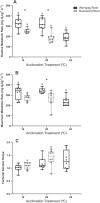Effects of acclimation temperature on the thermal physiology in two geographically distinct populations of lake sturgeon (Acipenser fulvescens)
- PMID: 34603733
- PMCID: PMC7526614
- DOI: 10.1093/conphys/coaa087
Effects of acclimation temperature on the thermal physiology in two geographically distinct populations of lake sturgeon (Acipenser fulvescens)
Abstract
Temperature is one of the most important abiotic factors regulating development and biological processes in ectotherms. By 2050, climate change may result in temperature increases of 2.1-3.4°C in Manitoba, Canada. Lake sturgeon, Acipenser fulvescens, from both northern and southern populations in Manitoba were acclimated to 16, 20 and 24°C for 30 days, after which critical thermal maximum (CTmax) trials were conducted to investigate their thermal plasticity. We also examined the effects of temperature on morphological and physiological indices. Acclimation temperature significantly influenced the CTmax, body mass, hepatosomatic index, metabolic rate and the mRNA expression of transcripts involved in the cellular response to heat shock and hypoxia (HSP70, HSP90a, HSP90b, HIF-1α) in the gill of lake sturgeon. Population significantly affected the above phenotypes, as well as the mRNA expression of Na+/K+ ATPase-α1 and the hepatic glutathione peroxidase enzyme activity. The southern population had an average CTmax that was 0.71 and 0.45°C higher than the northern population at 20 and 24°C, respectively. Immediately following CTmax trials, mRNA expression of HSP90a and HIF-1α was positively correlated with individual CTmax of lake sturgeon across acclimation treatments and populations (r = 0.7, r = 0.62, respectively; P < 0.0001). Lake sturgeon acclimated to 20 and 24°C had decreased hepatosomatic indices (93 and 244% reduction, respectively; P < 0.0001) and metabolic suppression (27.7 and 42.1% reduction, respectively; P < 0.05) when compared to sturgeon acclimated to 16°C, regardless of population. Glutathione peroxidase activity and mRNA expression Na+/K+ ATPase-α1 were elevated in the northern relative to the southern population. Acclimation to 24°C also induced mortality in both populations when compared to sturgeon acclimated to 16 and 20°C. Thus, increased temperatures have wide-ranging population-specific physiological consequences for lake sturgeon across biological levels of organization.
Keywords: Lake Sturgeon; mRNA expression; metabolic rate, acclimation; population-specific responses.
© The Author(s) 2020. Published by Oxford University Press and the Society for Experimental Biology.
Figures







Similar articles
-
The effects of population and thermal acclimation on the growth, condition and cold responsive mRNA expression of age-0 lake sturgeon (Acipenser fulvescens).J Fish Biol. 2021 Dec;99(6):1912-1927. doi: 10.1111/jfb.14897. Epub 2021 Sep 30. J Fish Biol. 2021. PMID: 34476812
-
Elevated temperatures reduce population-specific transcriptional plasticity in developing lake sturgeon (Acipenser fulvescens).Mol Ecol. 2023 Jul;32(14):4044-4062. doi: 10.1111/mec.16967. Epub 2023 May 7. Mol Ecol. 2023. PMID: 37150896
-
Elevated temperatures dampen the innate immune capacity of developing lake sturgeon (Acipenser fulvescens).J Exp Biol. 2023 May 15;226(10):jeb245335. doi: 10.1242/jeb.245335. Epub 2023 May 19. J Exp Biol. 2023. PMID: 37102716
-
Love thy neighbor: Social buffering following exposure to an acute thermal stressor in a gregarious fish, the lake sturgeon (Acipenser fulvescens).Comp Biochem Physiol A Mol Integr Physiol. 2020 May;243:110686. doi: 10.1016/j.cbpa.2020.110686. Epub 2020 Mar 3. Comp Biochem Physiol A Mol Integr Physiol. 2020. PMID: 32135300
-
Too Hot to Handle: A Meta-Analytical Review of the Thermal Tolerance and Adaptive Capacity of North American Sturgeon.Glob Chang Biol. 2024 Nov;30(11):e17564. doi: 10.1111/gcb.17564. Glob Chang Biol. 2024. PMID: 39563555
Cited by
-
Heatwave resilience of juvenile white sturgeon is associated with epigenetic and transcriptional alterations.Sci Rep. 2023 Sep 18;13(1):15451. doi: 10.1038/s41598-023-42652-7. Sci Rep. 2023. PMID: 37723229 Free PMC article.
-
Limited plasticity in thermally tolerant ectotherm populations: evidence for a trade-off.Proc Biol Sci. 2021 Sep 8;288(1958):20210765. doi: 10.1098/rspb.2021.0765. Epub 2021 Sep 8. Proc Biol Sci. 2021. PMID: 34493077 Free PMC article.
-
Transcriptional profiles reveal physiological mechanisms for compensation during a simulated marine heatwave in Yellowtail Kingfish (Seriola lalandi).BMC Genomics. 2025 Mar 11;26(1):230. doi: 10.1186/s12864-025-11283-9. BMC Genomics. 2025. PMID: 40069618 Free PMC article.
-
Identification of upper thermal thresholds during development in the endangered Nechako white sturgeon with management implications for a regulated river.Conserv Physiol. 2023 May 23;11(1):coad032. doi: 10.1093/conphys/coad032. eCollection 2023. Conserv Physiol. 2023. PMID: 37228298 Free PMC article.
-
Developmental plasticity in thermal tolerance: Ontogenetic variation, persistence, and future directions.Ecol Lett. 2022 Oct;25(10):2245-2268. doi: 10.1111/ele.14083. Epub 2022 Aug 25. Ecol Lett. 2022. PMID: 36006770 Free PMC article. Review.
References
-
- Aidos L, Cafiso A, Bertotto D, Bazzocchi C, Radaelli G, Giancamillo AD (2020) How different rearing temperatures affect growth and stress status of Siberian sturgeon Acipenser baerii larvae. J Fish Biol 96: 913–924. - PubMed
-
- Almroth BC, Asker N, Wassmur B, Rosengren M, Jutfelt F, Grans A, Sundell K, Axelsson M, Sturve J (2015) Warmer water temperature results in oxidative damage in an Antarctic fish, the bald notothen. J Exp Mar Biol Ecol 468: 130–137.
-
- Aloisi DB, Eckes OT, Von Eschen AJ (2019) Development of a growth model for lake sturgeon. N Am J Aquacult 81: 399–405.
-
- Bard B, Kieffer JD (2019) The effects of repeat acute thermal stress on the critical thermal maximum (CTmax) and physiology of juvenile shortnose sturgeon (Acipenser brevirostrum). Can J Zool 97: 567–572.
-
- Beitinger TL, Bennet WA, McCauly RW (2000) Temperature tolerances of North American freshwater fishes exposed to dynamic changes in temperature. Environ Biol Fish 58: 237–275.
LinkOut - more resources
Full Text Sources

